According to statistics, almost half of all appeals to a dermatologist, one way or another, is associated with fungal diseases. You can get the infection when visiting the pool, sauna, having visited the beach or visiting the master's slippers.
Learn all about how to recognize nail fungus on the legs without shaving and the use of other diagnostic methods - the symptoms of early stage onychomycosis manifestations.

Many do not even suspect that banal perspiration of the legs, accompanied by an unpleasant odor, that more than half of the population of our planet suffers, is one of the main symptoms of nail fungus. This disease risks getting sick than at least a little neglecting personal hygiene.
The nail fungus is waiting everywhere, especially in places of public use. And the worst is that nail fungus is a very insidious disease: its treatment is long and not always successful, because ringworm is inclined to relapses.
To recognize the disease over time and start your treatment, you should know all the signs of the fungus on your legs.
How does the disease spread?
The infection is caused by parasitic fungi. An ideal environment for its reproduction and development is the increased moisture in combination with a hot atmosphere. It is generally accepted that the main places where the risk of nail fungus infection is high is bath, saunas, water parks, swimming pools, manicure halls, etc.
However, statistics completely refute these statements: nail fungus can be collected at home through ordinary things (towels, shoes, clothes, rugs, shower or bathroom), whether one of the family members already has this problem, or at a party, for example, through slippers, kindly proposed by the owner (and he cannot suspect the presence of a disease).
But what factors affect the development of a fungal disease? These fundamental moments are observed, leading to infection with onychomycosis:
- decreased immunity;
- nail plate injury;
- Blood circulation violation at the lower ends, which may occur when wearing tight shoes;
- Pathologies of the feet of anatomical nature;
- obesity;
- Diabetes mellitus;
- Increased perspiration.
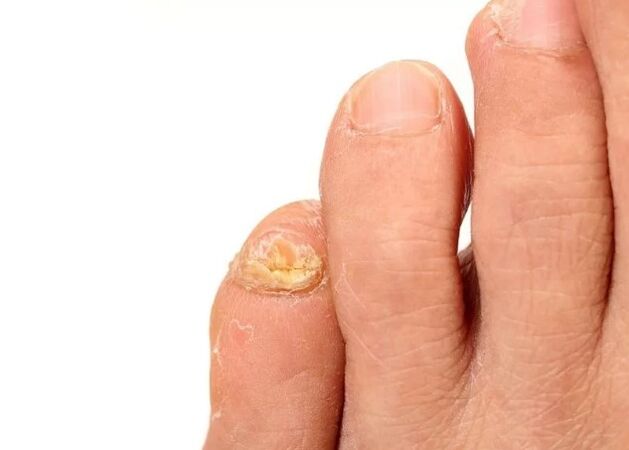
To at least protect yourself partially, you must use your things exclusively, carefully treat the bath and shower with antiseptic, use a personal towel, clean regularly and wash the rugs, disinfect shoes. And not to lose the time favorable to the treatment of ringworm (after all, everyone knows that therapy is more effective at the early stage of disease development), you need to know the first signs of nail fungus.
Having recognized the first signs of nail fungus, you should immediately contact a specialist who will prescribe the ideal treatment regime.
How do different types of onychomycosis manifest themselves?
3 Types of onychomycosis are determined, each of which manifests itself in its own signs.
You can determine the presence of a nail fungus, but only one specialist can establish a precise diagnosis. To do this, you need to visit the clinic, take to analyze the scraping of a painful nail or located around it. In addition, a dermatologist prescribes a microscopic or cultural study.
Signs of fungus by pathogen of the disease
The success of nail fungus treatment depends on how correctly the pathogen is diagnosed. This is explained by the fact that the disease does not cause a type of fungi, but several, and each is sensitive to certain medications. That is, if one type of fungus is resistant to a medicine, the other pathogen dies of this product.
More often, nail fungus causes:
- yeast;
- dermatophytes;
- mold.
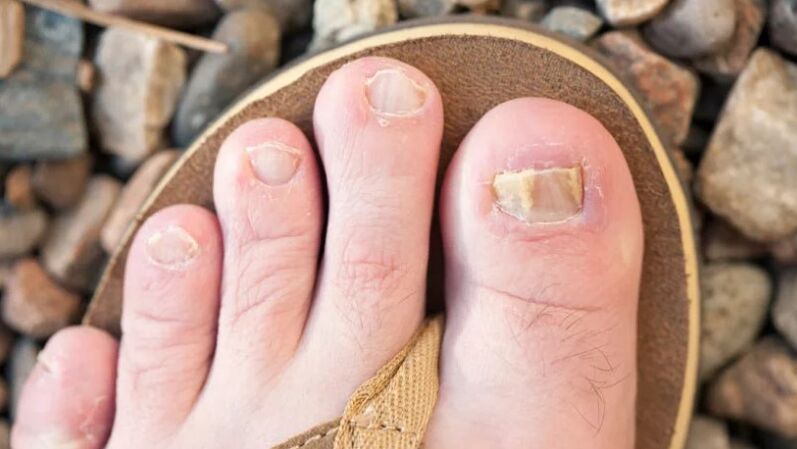
If the cause of nail fungus has become yeast, it is almost impossible to identify the disease immediately. The signs of the fungus on the leg nails in this case are as follows (they appear after a long period of time): peeling the nail plate and lightweight itching near the nail (itching may be absent). Binders' failure infection occurs in 4-4, 5% of cases.
Dermatophytes affect a person's nails much more often than the previous pathogen - this is 94, 5% of all cases of fungus nail infection. The dermatophytes are of three types, each manifests itself in different ways:
The last type of fungus is mold. Your pathogen is molds. This disease is found in only 1% of cases. A fungus of this species develops more often in people infected with HIV.
Other symptoms of fungal nail infection
Often, at the beginning of the disease, the obvious signs of damage caused by fungal nails are absent. However, to be careful, you may notice some changes in nail structure and its appearance.
As mentioned earlier, longitudinal or round whitish spots may appear on the nail plate, the nail can become similar to waves, while its softness and shine are lost.
Progressing, the disease more and more destroys the nail plate: first its shade changes, then the nail surface becomes climbing, thickened or thickens, relaxes, break. The color of the nail depends on what type of fungus became the causative agent of the infection.
In addition to the main signs of onychomycosis, there are others:
- the fragility of the nail plate edges or all its surface;
- Distortion of nail shape, scaly structure of its structure;
- Nail blacation;
- Cutting nails under the skin;
- dysbiosis, drowsiness, general weakness;
- Detachment of the nail bed plate, which leads to the formation of a plate under the nail of a whitish or yellow hue with an unpleasant odor;
- itching, cracking, burning the skin in the immediate vicinity of the affected nail;
- Dysbiosis, drowsiness, general weakness.
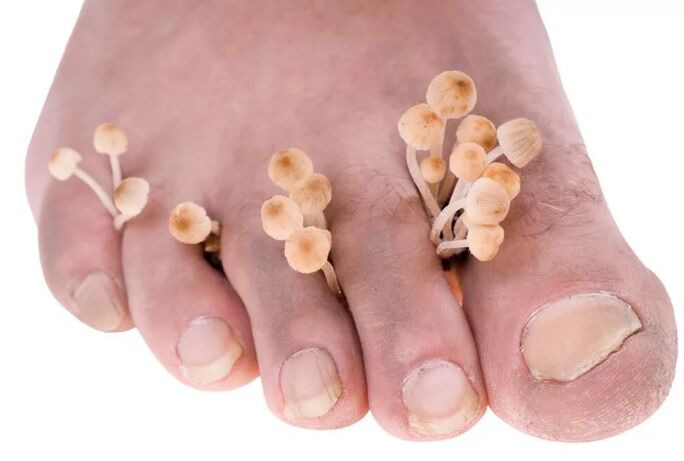
Any deviation in the appearance of nails on the legs should be alert as this may indicate the development of nail fungus. The first action in this case is a trip to a dermatologist who will confirm or refute his fears. If this is not done immediately, the disease will progress.
At first glance, there is nothing wrong with this disease. However, in addition to problems and purely aesthetic discomfort, the fungus can cause severe complications, until purulent infection of the affected areas and even the development of gangrene.
Therefore, do not tighten with treatment, take action at the same time, as the disease was detected.
How is the nail fungus
Each third person on Earth came across a problem such as nail stratification and shrinking, cloudy plate - this is onicomycosis. The disease affects various age groups. The nail fungus on the legs (the photos are presented below), spreads quickly and adapts to new conditions. We will consider in more detail the main factors of the occurrence, types and methods of treatment of the fungus.
What is nail fungus?
Onychomycosis is a pathology that destroys nail plates. The fungus eats keratin - the base of nail construction. The infection falls into the intercellular space and begins its division. In advanced stages, pathology is able to affect the skin of the feet, the intersion, the jumps.
Do not start the fungus and treat it immediately
Causes of nail fungus
One infected with onychomycosis is quite easy. The infection can hide on the beach, in the public soul, pool. A high probability of capturing a fungus of infected relatives or acquaintances (using ordinary lives).
There are several main prerequisites that can cause the virus to enter the human body:
- A weak immune system - a decrease in protective forces due to infectious or inflammatory diseases;
- Vascular pathologies (vein block) violations of internal organ work (diabetes), which leads to problems with blood circulation at the lower ends;
- Small skin damage to the feet (abrasions, microcrack, callus, grains) that emerged as a result of the use of tight shoes;
- Ignore diaper rash and intensive perspiration from the lower extremities;
- Violation of caution measures - Try someone else's shoes, visiting public places without slippers and neglecting leg hygiene.
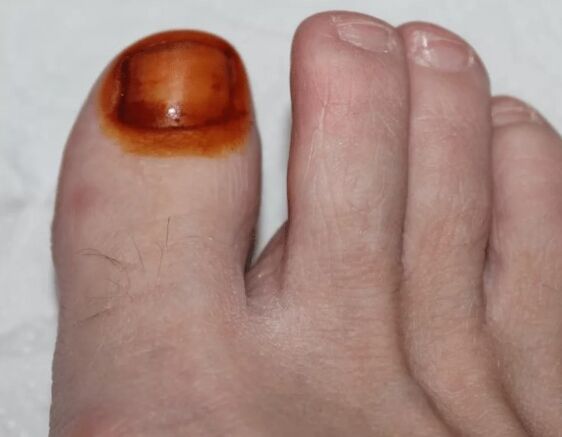
Nail fungus types
Onychomycosis can cause various types of fungi. Dermatophytes, for example, appear in the cloudy form of the nail. There is a formation of yellow spots along the edges or in the middle of the plate. In addition, longitudinal bands along the affected area can be observed.
In the final stages of nail fungus, surgical intervention may be required
The fungus of yeast causes the deformation of the nail plate. She is very sophisticated and begins to move away from her place, is gray. Metabolism in injured worse cells, the grooves appear in the roller of the nail. In addition, inflammation, edema and redness appear in the adjacent epidermis, the skin of the nail skin is observed.
Mold bacteria can impair nail plate if there are already diseases that cause nourishing nourishing disorders. In this case, there is also a cloudy of the plate, a change in its color (of light yellow and greenish to brown and even black).
To discover the cause and pathogen of negative changes on the skin and nails, you should contact a specialist. A determination regardless of the disease and its treatment without consulting a doctor may be full of consequences.
Folkloric methods
Against fungal infection at an early stage of development, non -traditional agents can be used. The following is the most effective:
- Every morning and before bed, until symptoms disappeared completely, apply iodine to nail plates hit by a mushroom;
- Mix 3 tablespoons of water with a teaspoon of glycerol, vinegar and iodine. The composition of nails for 10 days;
- Mix 9% vinegar with water in a proportion of 1 to 8. Dear the legs in the resulting liquid for 20 minutes. The procedures are repeated every day. There should be 7-10 of them in total;
- Place a raw egg in the container and pour 9% vinegar. After complete shell dissolution, remove the remaining movie, mix the vinegar with the egg. The solution is treated with nails infected with fungus twice a day for 3 weeks;
- Dissolve 4 teaspoons of hydrogen peroxide in 2 liters of water. In the container, lower your feet, keep them for 20 minutes. The course of treatment is 10 days;
- To moisten a peroxide cotton cotton swab, arrest to the nail, affected by a fungal infection. Before the procedure, the legs should be cooked steam in a soda bath. At the top, the compress is wrapped with cellophane. Keep for an hour. Therapy lasts 2 weeks;
- Damn a 20% alcohol canopy cotton pillow, secure an infected nail. Keep compaction until completely dry. The procedure is performed twice a day. Treatment continues until symptoms of the disease disappear completely;
- Clean the clove of the garlic, cut it on the floor. Wet in salt and grate the nail well. Procedures to do twice a day until the characteristics of the fungus disappear completely;
- Add 2 teaspoons of ammonia to a glass of water. In the solution, moisten a cotton pillow, apply -a to nails affected by the fungus, leave it at night. The course of therapy is 7 days;
- Move the onion carefully until the pamper is formed. Apply the product to infected nail plates for half an hour. The treatment is performed daily until complete recovery;
- Moa mint, sage and chamomile in equal proportions. Pour medicinal plants into the foot and put it in the night. Every day, the grass should be changed to the fresh. The tool is used as an addition to other methods;
- Take equal amounts of tea tree and celandine oil. To absorb a cotton pillow, put it in a nail infected for 45 minutes. The course of treatment is 20 days. The tool is not allowed to use during pregnancy;
- In 500 ml of water, it manufactures 6 teaspoons of nettle leaves. In a decoction, drive cotton, put it on nail plates with onychomycosis. Continue treatment until symptoms disappear completely.
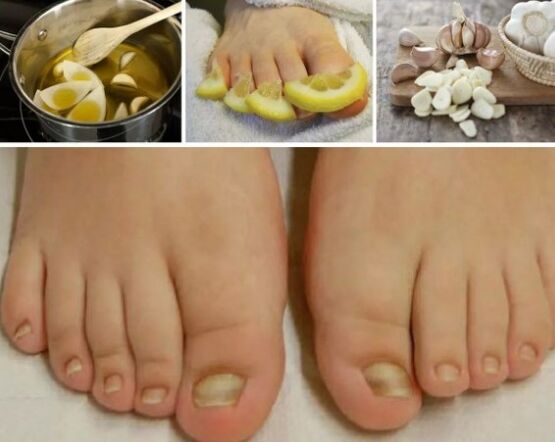
All popular remedies can only be used after consulting a dermatologist. Many of them are able to cause allergic reactions. It is easier to heal onicomycosis, combining non -traditional medications with medicines.
In the initial phase, the fungus on the legs looks like almost invisible grooves or white spots. Often one person learns about the presence of a fungal infection only during a visit to a dermatologist. This is due to the fact that it is almost impossible to recognize the disease during this period. If you start therapy on time, the disease will be cured quickly.
















